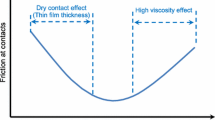Abstract
In order to establish a simplified viscosity evaluating method of high viscosity asphalt binders (HVABs), shear rate sweep test in the shear rate range of 1.25 × 10−6–1,250 s−1 was performed. Results showed that HVABs exhibited yield pseudo-plastic fluid behavior at 60 °C and the overlapped range of the first Newtonian region was 8 × 10−5–2 × 10−2 s−1. Based on the results, the simplified shear rate sweep test in the shear rate range of 0.001–0.1 s−1 was proposed and low shear viscosity at 0.01 s−1 (LSV0.01) was suggested as the viscosity evaluating indicator of HVABs, which exhibited both close values to zero shear viscosity and significant correlation with rutting resistance of porous asphalt.




Similar content being viewed by others
References
ASTM Standard D04 (2008) Road and paving materials. ASTM International, West Conshohocken. doi:10.1520/D7175-08
ASTM Standard D04 (2010) Road and paving materials. ASTM International, West Conshohocken. doi:10.1520/D2171-10
ASTM Standard D04 (2010) Road and paving materials. ASTM International, West Conshohocken. doi:10.1520/D7405-10A
Barnes HA, Hutton JF, Walters K (1989) An introduction to rheology, vol 3. Elsevier, Amsterdam
CEN/TS 15324 (2008) Bitumen and bituminous binders: determination of equiviscous temperature based on low shear viscosity using a dynamic shear rheometer in low frequency oscillation mode. European Committee for Standardization, London
CEN/TS 15325 (2008) Bitumen and bituminous binders: determination of zero shear viscosity (ZSV) using a shear stress rheometer in creep mode. European Committee for Standardization, London
De Visscher J, Vanelstraete A (2004) Practical test methods for measuring the zero shear viscosity of bituminous binders. Mater Struct 37(5):360–364
Desmazes C, Lecomte M, Lesueur D, Phillips M (2000) A protocol for reliable measurement of zero-shear-viscosity in order to evaluate the anti-rutting performance of binders. In: Proceedings of 2nd Eurasphalt & Eurobitume Congress, Barcelona
Izumoto R (2000) Asphalt modifier, process for producing modified asphalt, and process for producing road pavement material, publication no. WO2000046304. World Intellectual Property Organization, Geneva
Japan Road Association (1996) Technical manual of porous asphalt pavement. Maruzen Publishing Co., Ltd., Tokyo
JMAAS-01 (2007) Japan Modified Asphalt Association Standard. Japan Modified Asphalt Association, Tokyo
Larson RG (1999) The structure and rheology of complex fluids, vol 2. Oxford University Press, New York
Li L-H, Geng H, Sun Y-N (2010) Evaluation method and indicator for viscosity of high-viscosity asphalt. J Constr Build Mater 13(3):352–362
Meng Y-J, Zhang X-N, Jia J (2008) Research on zero shear viscosity of asphalt based on different loading modes. J Traffic Transp Eng 8(4):35–38
Nakanishi H (2002) Study on improvement in durability of function for porous asphalt pavement. Guangxi Commun Sci Technol 27(102):7–12
Research Institute of Highway Ministry of Transport (2004) Technical specifications for construction of highway asphalt pavements. Ministry of Transport of People’s Republic of China, Beijing
Research Institute of Highway Ministry of Transport (2011) Standard test methods of bitumen and bituminous mixtures for highway engineering. Ministry of Transport of People’s Republic of China, Beijing
Shanghai Municipal Engineering Design Institute (Group) Co., Ltd. (2010) Technical code for drainage asphalt pavement of road. Shanghai Urban Construction and Communications Commission, Shanghai
Sybilski D (1993) Non-Newtonian viscosity of polymer-modified bitumens. Mater Struct 26(1):15–23
Sybilski D (1996) Zero-shear viscosity of bituminous binder and its relation to bituminous mixture’s rutting resistance. Transp Res Rec 1535(1):15–21
Wang S, Ma Q, Li J (2012) Study and application progress of high viscosity modified asphalt used in porous pavement. Pet Asph 26(1):1–7
Acknowledgments
Professor Weimin Lyu provided useful discussion and advice for the research, whose help is gratefully acknowledged. The authors would also like to acknowledge Mr. Xurong Ma who performed vacuum capillary viscometer test for the research.
Author information
Authors and Affiliations
Corresponding author
Rights and permissions
About this article
Cite this article
Li, L., Geng, H. & Sun, Y. Simplified viscosity evaluating method of high viscosity asphalt binders. Mater Struct 48, 2147–2156 (2015). https://doi.org/10.1617/s11527-014-0299-2
Received:
Accepted:
Published:
Issue Date:
DOI: https://doi.org/10.1617/s11527-014-0299-2




